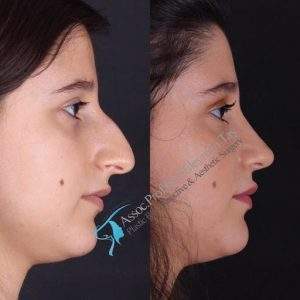Open vs Closed Rhinoplasty
Rhinoplasty is one of the most preferred plastic surgery in the world. Patients can benefit from rhinoplasty for functional or aesthetic reasons. Patients who are searching for rhinoplasty surgery will face two different techniques: Open and Closed Rhinoplasty Techniques. In this article, we will be talking about the differences between open and closed rhinoplasty techniques. Firstly let’s take a look at what both open and closed techniques mean.

OPEN RHINOPLASTY
On open rhinoplasty techniques muscles, bonds and all other tissues will be opened with a cut on the columella which is the place between two nostrils. Thus, cartilage and bone tissue can be seen. This helps the surgeon to see the anatomy of the nose easily. This technique is preferred by surgeons who want to see the whole anatomy. A scar will remain since there’s a cut on the external tissue. After all the tissues are opened there can be damage on the vessels. Due to this situation swelling and bruising can be major. This causes the healing process to be longer. The opened technique is performed on general anesthesia. The surgery lasts about one or two hours. After the surgery on the night at the hospital is recommended.
CLOSED RHINOPLASTY
Closed rhinoplasty technique is a technique that does not require external cuts. By this, no scar is created on the external tissue; that means no scar healing process and minimum infection risks. This technique is also called scarless rhinoplasty. Closed rhinoplasty presents lots of benefits for the patient that is why lots of people choose it. Since there is no cut on the external tissue patient doesn’t have to avoid the sun as much as opened technique. Within 7 or 10 days, the cast will be removed and the patient get back her/his social life faster. Closed technique is also performed on general anesthesia. The surgery lasts about two to four hours. One night at the hospital is recommended by the surgeon.
Closed rhinoplasty prevents damage to muscles and tissues. As there’s no damage to the soft tissue more natural look can be achieved. There will be edema since this is a surgery but it will decrease in a shorter time and the healing process will be less long compared to opened technique.
With the development of endoscopes, camera systems, micromotor techniques closed rhinoplasty became more popular. To popularize this hard technique lots of courses are being held. The closed technique allows the doctor to see where the skin sits. No cutting on the pitanguy’s ligament allows preserving the sense and moveability of the nose tip.
Differences Between Open and Closed Rhinoplasty Techniques:
The major difference between the two techniques is on the open technique there’s a cut on the external tissue, on the closed technique the cut is inside of the nose. This causes basic differences. We can sort the differences as:
- The cut is on the inside of the nose when the closed technique is performed on the other hand the cut is on the outside of the nose when an open technique is performed.
- No scar will remain when the closed technique is performed but the scar can remain when an open technique is performed.
- With the minimal touches on closed technique, the damage on the soft tissues is prevented. On the flip side, there’s a chance of damaging the soft tissues since all the tissues opened on open technique.
- Due to the fact that damage can be done on the vessels on open technique healing process is longer compared to closed technique.
Rhinoplasty in Turkey: Dr. Suleyman TAS prefers Closed Atraumatic Rhinoplasty in his practice. Closed Rhinoplasty is more close to Atraumatic philosophy.
It is also beneficial to talk about atraumatic philosophy since it is related to closed rhinoplasty. ‘’Atraumatic’’ means not traumatized, not damaging; fragile, sensitive surgery. This technique can be applied to every kind of surgery. Let’s give an example to understand more of what atraumatic means: suggest there’s excess cartilage on the nose tip and this situation makes the nose look bigger. With an atraumatic perspective, instead of narrowing the cartilage, it can be folded on itself. This way it is possible to make the cartilage stronger and more narrow. For another example; To remove the hump in the nose we can get through the nostrils and reach the nasal bone. While doing that we can do it with an under the skin/fascia plan which will cause damage on blood vessels and will create more edema and bruising after the operation or with a submembranous dissection plan which will give us the opportunity to not cause any damage on blood vessels.

Revision rhinoplasty term is used for an extra operation for patients who don’t like their nose aesthetically or functionally. In the medical literature, the revision rate is 5%-30%. But in our clinical practice, the revision rate is less than %1.
There can be a lot of reasons to choose revision rhinoplasty. Revision can be performed open or closed technique depending on the surgeon’s choice. Revision surgeries can be performed more than once but in every time success rate decreases and compilation risks increase. That is why it is very very important for the first surgery to be successful which can be achieved with experienced, reliable hands.
USED LATEST TECHNOLOGY in OPEN and CLOSED RHINOPLASTY
Piezo (Ultrasonic) technology is firstly used in oral and dental surgery. This technique does not require bone-breaking, instead, vibrations created by sound waves are used. With this technique, there will be no damage to the soft tissues. As so the recovery process will be shorter. This technology is used during open rhinoplasty since it has a rough handle.
Micromotor technology is also a very new technique that needs no breaking bones or the usage of sharp tools. It is the latest technology. It’s been used for almost 10 years now. This allows the surgeon to operate easily on the small areas. It is easier and faster now to smoothly shape the cartilage. With this pinpointing, bleeding and edema can be decreased. This ensures minimal bruising and swelling. Micromotor technology enables to interfere delicately on nose bones with 2 mm thin tips. With these fine tips, there is no using force on the bones. There’s no damage to the soft tissue. In favor of this, the surgeon can do millimetric touches. This technology is used during closed rhinoplasty since it has a gentle handle.














